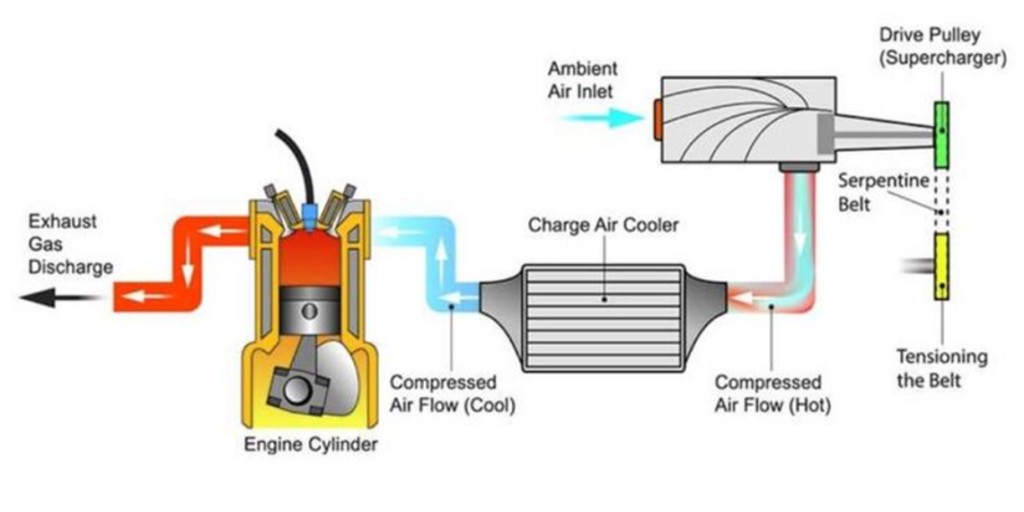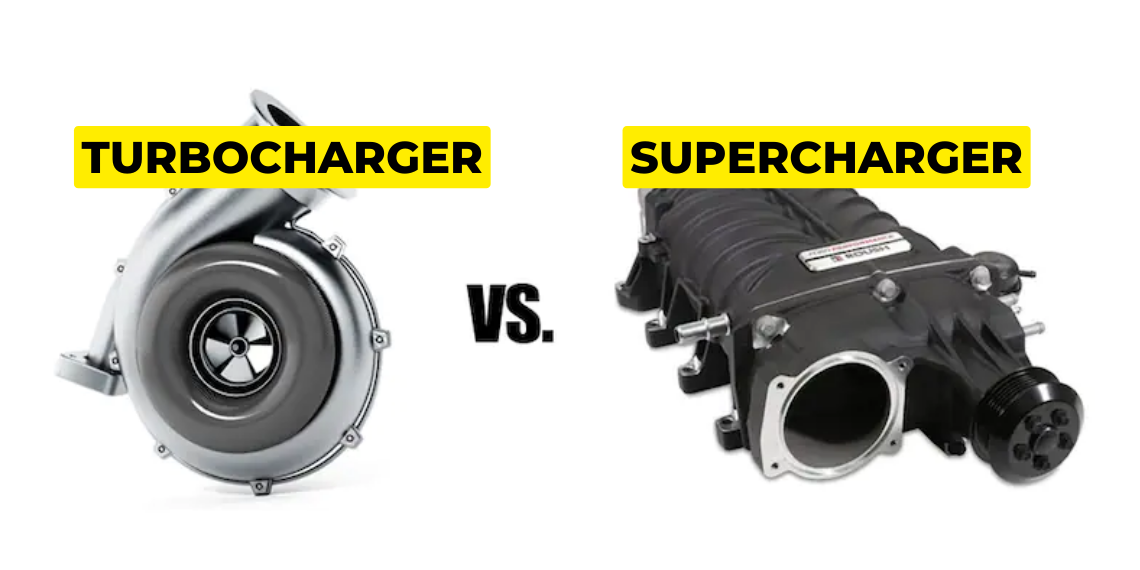Turbocharger & Supercharger
In this blog, we will discuss what a Turbocharger is, how it is designed and various types of turbochargers based on its design. Along with it, we will deeply focus on various turbocharging systems we use onboard. Later on, in the upcoming blog, we will learn about the working, surging, maintenance precautions, etc. related to turbochargers.
1:- What is a Turbocharger?
A turbocharger has an impact on an internal combustion engine’s performance and output. It’s a device driven by a turbine to force extra air into the combustion chamber. This allows more fuel to burn, which leads to a big boost in power.
2:- Construction of Turbocharger
3:- Components of a Turbocharger
1. Turbine:
- Function: Converts exhaust gas energy into rotational energy to drive the compressor.
- Key Components: Turbine housing, turbine wheel, and nozzle ring.
2. Compressor (Blower):
- Function: Draws in and compresses ambient air to increase the air density entering the engine.
- Key Components: Compressor housing, compressor wheel, and diffuser.
3. Inducer:
- Function: Guides the airflow smoothly into the compressor wheel, minimizing turbulence and maximizing efficiency.
- Key Component: The inlet section of the compressor wheel with specially designed blades.
4. Diffuser:
- Function: Converts the high-velocity, low-pressure air exiting the compressor wheel into high-pressure, low-velocity air.
- Key Component: A set of stationary vanes surrounding the compressor wheel.
5. Labyrinth Seals:
- Function: Minimize oil and air leakage between the rotating and stationary components of the turbocharger.
- Key Components: A series of interlocking teeth or grooves machined into the shaft and housing.
6. Bearings :
- Function: Support the rotating shaft and allow it to spin freely with minimal friction.
- Key Components: Ball bearings or journal bearings, bearing housing, and oil supply.
7. Nozzle:
- Function: Directs the flow of exhaust gasses onto the turbine wheel at the optimal angle for maximum power extraction.
- Key Components: Nozzle ring with a series of fixed or variable vanes.
8. Filters:
- Function: Prevent debris and contaminants from entering the turbocharger and damaging the delicate components.
- Key Components: Air filter for the compressor inlet and oil filter for the lubrication system.
9. Manometer:
- Function: Measures the pressure difference between the compressor inlet and outlet to monitor turbocharger performance and detect potential issues.
- Key Components: Pressure sensing element, display or gauge, and connecting hoses.
10. Wastegate:
- Usually, it is done by nozzles in ships.
- It may not always be one, two, or all of them but they compromise our safety when we need to cross the roads or run away.
- A waste-gate valve regulates the quantity of exhaust gases that pass to the turbine wheel to prevent overspeeding.
11. Scavenge Air Cooler:
- It does not need to be present all the time but when it appears, it plays a major role.
- Cools the compressed air before it enters the engine thus increasing its density and thus improving the efficiency.
4:- Pulse Type Turbocharger
4.1:- Principle of Pulse Type Turbocharger
It employs the pressure variations within the exhaust gasses and specifically, what occurs with the pulse of exhaust gasses that leaves every cylinder. Individual rather than continuous emissions take place in the form of pulsating flow of the exhaust gases. These pulses reach the turbine blades with greater velocity and energy and therefore give a faster response and efficiency, especially at lower rpm of the engine.
4.2:- System Arrangement
- Individual Exhaust Manifolds: In any given cylinder, there is an exhaust manifold or an exhaust pipe.
- Exhaust Grouping: The headers are frequently combined by the firing order of the engine. This makes sure that the exhaust pulses of the different cylinders get to the turbine at different intervals to cause a more effective effect on the blades of the turbine.
- Nozzles: The exhaust pipes can be grouped sometimes and they end with nozzles that can project the exhaust pulses on certain portions of the turbine wheel.
4.3:- Advantages of Pulse Type Turbocharger
- Rapid Response: Due to straight-through exhaust pulses, there is an effective response to variations in the engine load, and therefore little turbo lag.
- Improved Low-Speed Performance: These high energy pulses improve the turbine’s efficiency when engine speed is low thereby increasing torque and response.
- Better Scavenging: The pressure waves themselves from the exhaust pulses can be used to pump even more air out of the cylinders, making it even more efficient.
4.4:- Disadvantages of Pulse Type Turbocharger
- Higher Exhaust Back Pressure: Here, the exhaust manifolds are split and have complex piping, which can comprise high-speed exhaust back pressure.
- Increased Complexity: The pulse system is generally more difficult and costly than the top-fed system also because of the extra pipes and nozzles involved.
- Noise: These can increase the difference in pulses which in turn can make the exhaust note louder.
4.5:- Applications of Pulse Type Turbocharger
The pulse system is particularly well-suited for:
- Onboard ships: They are mainly used in the auxiliary engine
- Smaller Engines: In cases where some of the specific attributes include low-speed responsiveness and torque.
- Applications with Frequent Load Changes: How rapid response is possible.
- Example: Pulse system is used in small—and mainly in marine diesel engine applications—as well as some automotive applications (specifically diesel).
5:- Constant Pressure Turbocharging:
5.1:- Core Principle of Constant Pressure Turbocharging
In a constant pressure system, the exhaust gasses, coming out from each cylinder, are channeled to a single exhaust manifold. This flattens out the pressure pulses to make the exhaust gas flow to the turbine more intermittent and smooth. It also puts a heavy focus on maintaining the operation of the turbines and their efficiency with more focus on how efficient the engines are at higher RPMs.
5.1:- System Arrangement
- Common Exhaust Manifold: Another peculiarity of all diesel engine cylinders is the exhaust manifold that incorporates a single, large collector.
- Exhaust Piping: The material joining the manifold and the head is a single exhaust pipe that goes to the turbine housing.
- As a result, there are certain benefits of employing the constant pressure system in various organizations.
5.2:- Advantages of Constant Pressure Turbocharging
- Lower Exhaust Back Pressure: The single manifold and larger pipe diameter create less resistance and back pressure to the exhaust gasses hence enhancing the high speed performance of the car.
- Simpler and Cost-Effective: The system is less complex and therefore has more components and the number of pipes required to connect each component.
- Smoother Operation: Due to the constant flow of exhaust gases, the operation of turbines becomes more efficient and they wear out less.
- Higher Efficiency at High Loads: The system works best when the engine is heavily laden since a large volume of exhaust is produced.
5.3:- Disadvantages of Constant Pressure System
- Slower Response: This gets even worse when it does not have pressure pulses, meaning that it takes a comparatively longer time to respond to changes in engine load meaning more turbo lag.
- Reduced Low-Speed Performance: The constant pressure system is normally less effective when the engine speed is low since the energy recovery from the exhaust stream is low.
5.4:- Applications of Constant Pressure Turbocharging
The constant pressure system is commonly used in: The constant pressure system is commonly used in:
- Larger Engines: Where high-speed performance and high efficiency are the key factors.
- Applications with Steady Loads: Where immediate response is not very important.
- Example: The constant pressure system is utilized in large Marine Diesel Engines, Power generation plants, and some Heavy-Duty Automotive Applications.
6:- Types of Turbochargers
6.1:- Radial Turbochargers
Design:
- Implement the use of a centrifugal type of compressor and a radial imparting turbine of a jet engine.
Advantages:
- Closely connected with this is one more of its advantages, which consists in the moderate reliability of the layout and its simplicity.
- Lower cost
- Best used with small engines and low amounts of power.
Disadvantages:
- Quite inefficient for high-pressure ratios and mass flow rates
- Higher back pressure
- moderate or low utilization of other better-developed technologies for example variable geometry
Lubrication:
Usually managed by way of a fundamental oil feed and dropping from the engine.
6.2:- Axial Turbochargers
Design:
- State that an axial flow compressor and turbine must be designed, and the flow of the working fluid is generally in parallel with the rotation axis of the compressor or turbine.
Advantages:
- Superior compliant in high-pressure ratio and Mass flow rates
- Lower back pressure
- More suitable for large engines and needs more power.
- It was further opened to new implements
Disadvantages:
- Slightly less in low-speed
Lubrication:
Mores often require dual or multiple high-pressure fluid delivery systems with one or more pumps, coolers, and/or filters due to the higher load and temperature.
6.3:- Mixed-Flow Turbochargers
Design:
- Ideally, it uses design aspects of both radials and axials and is typically made up of a radial turbine and an axial compressor.
Advantages:
- Expenses should be made to come up with a middle ground between radial more so axial ideas
- It will most probably lead to a good matching for a precursor between efficiency, cost, and robustness
Disadvantages:
- Hasteners high efficiency at high flow rate is not equal to the efficiencies of the other purely axial pumps.
- Lubrication: For the diffusion, the systems depending on the specific design can be comparable to the ones used for the axial ones.
7:- Supercharger
A supercharger is a device that increases air pressure supplied to an IC engine with a belt-driven shaft mechanism.

7.1:- Working of a Supercharger:
A supercharger increases the amount of air entering an engine by compressing it before it enters the combustion chamber. A supercharger is driven by a belt connected to an engine’s crankshaft which rotates the blower attached to it through a shaft. When the blower rotates it draws in air and compresses it at a higher pressure which increases the temperature. To further optimize the performance, the fresh air goes through a cooler before entering the system increasing its density. This cooling process actively enhances the density of the air, allowing for a greater amount of oxygen-rich air to be supplied, leading to improved combustion and increased engine power output.

One major drawback of a supercharger is that 30-35% of the energy of the crankshaft is lost while rotating the shaft.
7.2:- Why do we Prefer a Turbocharger over a Supercharger on a Ship?
In ships, turbochargers are generally preferred over superchargers because they are more efficient at providing the necessary boost to the engine. Turbochargers are powered by the exhaust gases from the engine which would otherwise be wasted, which are used to spin a turbine that compresses the incoming air before it enters the engine. This compressed air results in more fuel being burned during the combustion process, which in turn produces more power.
Superchargers, on the other hand, are driven by a belt or chain that is connected to the engine’s crankshaft. This means that they require power from the engine to operate, which can reduce overall engine efficiency. This means that turbochargers can provide more compressed air to the engine for the same amount of energy input, leading to better fuel efficiency.
8:- Difference between Turbocharger and Supercharger
| Turbocharger | Supercharger |
| A turbocharger is driven by the engine’s exhaust gases. | A supercharger is driven directly by the engine via a belt or chain. |
| Turbochargers are generally more efficient than superchargers because they use waste energy from the exhaust gases to drive the compressor. | While superchargers draw power directly from the engine’s crankshaft, which can result in reduced efficiency |
| Turbochargers typically have some lag time while starting the engine due to lack of exhaust gas, which can result in a delay in power delivery. | Turbochargers typically have some lag time while starting the engine due to a lack of exhaust gas, which can result in a delay in power delivery. |
Disclaimer :- The opinions expressed in this article belong solely to the author and may not necessarily reflect those of Merchant Navy Decoded. We cannot guarantee the accuracy of the information provided and disclaim any responsibility for it. Data and visuals used are sourced from publicly available information and may not be authenticated by any regulatory body. Reviews and comments appearing on our blogs represent the opinions of individuals and do not necessarily reflect the views of Merchant Navy Decoded. We are not responsible for any loss or damage resulting from reliance on these reviews or comments.
Reproduction, copying, sharing, or use of the article or images in any form is strictly prohibited without prior permission from both the author and Merchant Navy Decoded.




Im a dream package student, and due to this package, I have known alot and increased my basics knowledge, which is helping me in my current job as well, im also a GME aspirant.
I suggest who ever is reading this and didnot buyed any of the package, but want to learn more, then my recommendation is that, do buy and see how it will change your technical knowledge.
Thank you MD Shamim uddin,
I hope you liked the blog, there are more blogs like this already uploaded and more blogs are going to be uploaded in this website.
Please check those too.
Team Merchant Navy Decoded